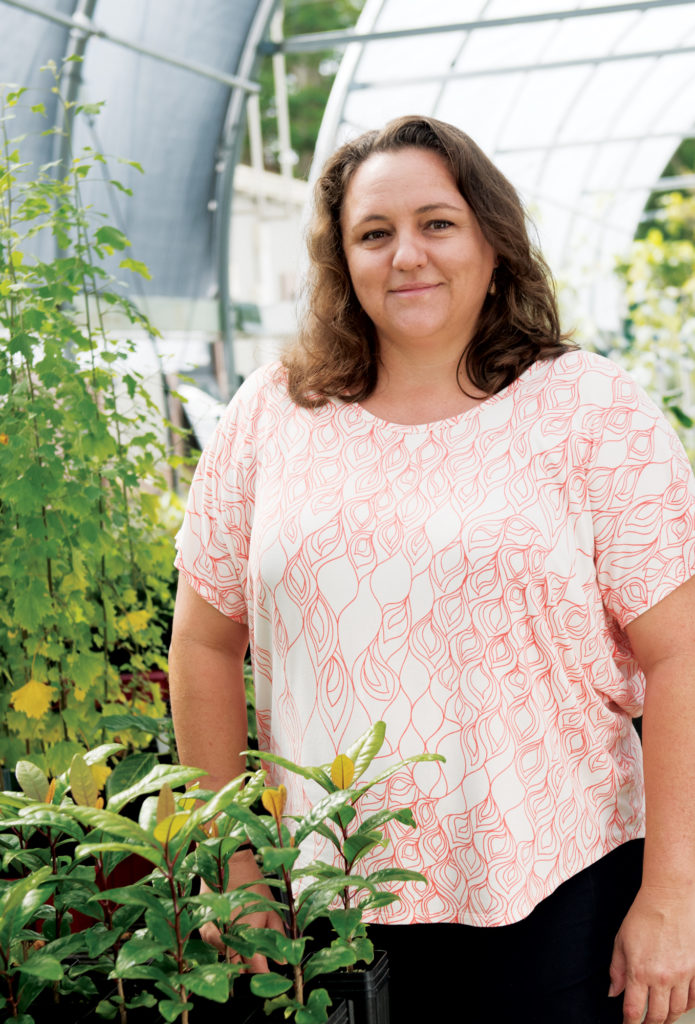
By Erin Teruya ’93 Kinney
In the Field
It doesn’t happen as often as she’d like anymore, but the best days on the job for Jane Beachy ’97 are the ones spent outdoors. As Ecosystem Restoration Program Manager supporting the U.S. Army’s O‘ahu Natural Resources Program at Schofield Barracks, Beachy is an environmental superhero whose target is invasive weeds. Her good deeds create healthy habitats for endemic and indigenous plants, birds, arthropods and snails located in and around Army training areas.
On a recent afternoon, Beachy’s focus was on a really bad weed, Chromolaena odorata, in the Kahuku Training Area. Lined up four meters apart and bearing compasses, Beachy and her team moved up and down through thick vegetation seeking out the target weed in a 20-acre area.
“I do more planning now, and I get out when I can,” explains Beachy. “But I don’t get out as much as I would love to.”
Nature was always a draw for Beachy. She grew up hiking with her mom, Martha Reppun ’63, dad Glenn, brother Evan ’94 and her large extended family. (Glenn is the School’s longtime athletic trainer.) The summer before her senior year at Punahou, Beachy was hired as an intern for a Nature Conservancy program designed to introduce high school students to careers in conservation. The program allowed her to spend time on O‘ahu and neighbor islands visiting unique habitats, doing weed control, cleaning up beach debris and visiting University of Hawai‘i laboratories. One of the visits included a day with her future employer, where she built fences. “It was an awesome summer and a great introduction to conservation.”
At Harvard University where she completed her undergraduate studies, Beachy found a good fit in the relatively new environmental science and public policy department. She reveled in the range of classes available to her, from biology to economics, conservation biology and landscape architecture.
Always with an eye on her passion, Beachy spent yet another summer on the ‘aina through a work-study job with the Federal Student Aid Program. “I emailed a bunch of organizations that I had met and offered myself as cheap labor,” Beachy laughs. Her days were spent checking pig snares, building fences, conducting snail surveys, monitoring rare plants and controlling weeds. The internship eventually led to full-time employment supporting the Army’s program, where she’s been since 2001.
Beachy and her team are contracted through the University of Hawai‘i and the Pacific International Center for High Technology Research to the Army Natural Resource Program to do environmental work on military training land. Their work is directed by two enormous documents, the Mākua Implementation Plan and the O‘ahu Implementation Plan, both 30-year plans, and the federal Endangered Species Act, intended to mitigate the Army’s impact and protect endangered species on training lands.
“I think with conservation in general, anywhere in Hawai‘i, 30 years seems like a long time, but when you’re talking about restoring an ecosystem, there’s some plants that may only mature after 10 years, or even later, so really you have to be thinking even more long term than that,” says Beachy. “At our office, we’re very conscious of the plan, but we’re also very conscious about trying to make an impact in the long term.”
The implementation plans have allowed the program to grow from its small staff of six in 2001 to its current 55. Beachy is one action figure in a Justice League of superheroes. Others are focused on fencing out ungulates. Field teams spray invasive weeds and plant seedlings, and an on-site seed lab stores and propagates endangered plant species. The staff protects more than 1,400 acres on O‘ahu and control weeds on more than 55,000 acres each year.
Progress is measured in decades, not days, and Beachy, with more than 17 years in the field, has only recently begun to recognize her accomplishments. At Mākua, the hāhā, one of the area’s most endangered plants, was near extinction 20 years ago with fewer than 10 plants remaining. Today, more than 100 hāhā thrive in Mākua’s gulches, with many more on neighboring state land.
In January, Beachy was invited by Academy faculty member John Chock ’01 to be a guest speaker at a G-Term lei making course, “Ka Hana Lei.” During the four-day course, students were introduced to plantsmanship and craftsmanship of lei making and worked in campus greenhouses and the lei garden. Beachy guided the class in identifying different plant parts used in lei and explained the conservation work that she and her team do.
“I got excited putting together my presentation,” says Beachy. “I was thinking of all the things that got me excited about conservation, and I tried to focus on why Hawai‘i is so unique, because we really are. So few people in Hawai‘i even know what a native plant is. I just wish that more people had an opportunity to make the connection.”
See related profiles about Vanessa Van Gorder ’95 Distajo and Lee Zane ’88
